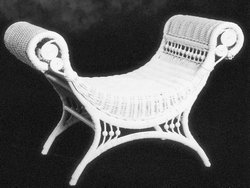
Click for an animation of the
sella turcica
UPDATED: The words [sella turcica] are Latin and mean "Turkish chair". The sella turcica is a depression found in the superior aspect of the sphenoid bone and it does resemble one! The accompanying image is that of a Turkish chair made in wicker. (wickerbydesign.com). The Turkish chair resembles a horse saddle with high ends.
If you click on the image, you will see an animation of the sphenoid bone highlighting the sella turcica, where you will see the resemblance between the chair and the bone.
The hypophysis or pituitary gland, which dangles from the hypothalamus by a neural stalk, is found within the concavity of the sella turcica, surrounded by the optic tracts laterally and by the optic chiasm anteriorly.
The depression of the sella turcica is sometimes called the [pituitary fossa] or [fossa hypophyseos]. It is bound anteriorly and posteriorly by four bony processes, the (left and right) middle and posterior clinoid processes.
The pituitary fossa is closed by a tent-like structure made of dura mater which has a small opening that allows the hypophyseal stalk to pass trough. This is the diaphragma sellae.
Question: Do you know that there are four named diaphragms in the human body? See if you can name them!
Image of the Turkish chair courtesy of wickerbydesign.com.Secondary animated image byBodyParts3D, courtesy of Wikipedia.



